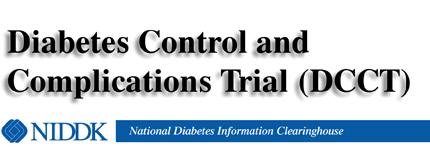 |
|
|
|
What Is the DCCT? |
The DCCT is a clinical study conducted from 1983 to 1993 by the National Institute of Diabetes and Digestive and Kidney Diseases (NIDDK). The study showed that keeping blood sugar levels as close to normal as possible slows the onset and progression of eye, kidney, and nerve diseases caused by diabetes. In fact, it demonstrated that any sustained lowering of blood sugar helps, even if the person has a history of poor control. The largest, most comprehensive diabetes study ever conducted, the DCCT involved 1,441 volunteers with insulin-dependent diabetes mellitus (IDDM) and 29 medical centers in the United States and Canada. Volunteers had diabetes for at least 1 year but no longer than 15 years. They also were required to have no, or only early signs of, diabetic eye disease. The study compared the effects of two treatment regimens--standard therapy and intensive control--on the complications of diabetes. Volunteers were randomly assigned to each treatment group. |
How Did Intensive Treatment Affect Diabetic Eye Disease? |
All DCCT participants were monitored for diabetic retinopathy, an eye disease that affects the retina. Study results showed that intensive therapy reduced the risk for developing retinopathy by 76 percent. In participants with some eye damage at the beginning of the study, intensive management slowed the progression of the disease by 54 percent. The retina is the light sensing tissue at the back of the eye. According to the National Eye Institute, one of the National Institutes of Health, as many as 24,000 persons with diabetes lose their sight each year. In the United States, diabetic retinopathy is the leading cause of blindness in adults under age 65. |
|
DCCT Study Findings Lowering blood sugar reduces risk: Eye disease 76% reduced risk Kidney disease 50% reduced risk Nerve disease 60% reduced risk Cardiovascular disease 35% reduced risk |
|
How Did Intensive Treatment Affect Diabetic Kidney Disease? |
Participants in the DCCT were tested to assess the development of diabetic kidney disease (nephropathy). Findings showed that intensive treatment prevented the development and slowed the progression of diabetic kidney disease by 50 percent. Diabetic kidney disease is the most common cause of kidney failure in the United States and the greatest threat to life in adults with IDDM. After having diabetes for 15 years, one-third of people with IDDM develop kidney disease. Diabetes damages the small blood vessels in the kidneys, impairing their ability to filter impurities from blood for excretion in the urine. Persons with kidney damage must have a kidney transplant or rely on dialysis to cleanse their blood. |
How Did Intensive Treatment Affect Diabetic Nerve Disease? |
Participants in the DCCT were examined to detect the development of nerve damage (diabetic neuropathy). Study results showed the risk of nerve damage was reduced by 60 percent in persons on intensive treatment. Diabetic nerve disease can cause pain and loss of feeling in the feet, legs, and fingertips. It can also affect the parts of the nervous system that control blood pressure, heart rate, digestion, and sexual function. Neuropathy is a major contributing factor in foot and leg amputations among people with diabetes. |
How Did Intensive Treatment Affect Diabetes-Related Cardiovascular Disease? |
DCCT participants were not expected to have many heart-related problems because their average age was only 27 when the study began. Nevertheless, they underwent cardiograms, blood pressure tests, and laboratory tests of blood fat levels to look for signs of cardiovascular disease. The study proved that volunteers on intensive treatment had significantly lower risks of developing high cholesterol, a cause of heart disease. The risk was 35 percent lower in these volunteers, suggesting that intensive treatment can help prevent heart disease. |
Elements of Intensive Management in the DCCT |
|
What Are the Risks of Intensive Treatment? |
In the DCCT, the most significant side effect of intensive treatment was an increase in the risk for low blood sugar episodes severe enough to require assistance from another person. This is called severe hypoglycemia. Because of this risk, DCCT researchers do not recommend intensive therapy for children under age 13, people with heart disease or advance complications, older adults, and people with a history of frequent severe hypoglycemia. Persons in the intensive management group also gained a modest amount of weight, suggesting that intensive treatment may not be appropriate for people with diabetes who are overweight. DCCT researchers estimate that intensive management doubles the cost of managing diabetes because of increased visits to health care professional and the need for more frequent blood testing at home. However, this cost is offset by the reduction in medical expenses related to long-term complications and by the improved quality of life of people with diabetes. |
|
Results of the DCCT are reported in the New England Journal of Medicine, 329(14), September 30, 1993. Other articles related to the DCCT will be published in various journals during the next few years. For reprints of articles, please write to: National Diabetes Information Clearinghouse 1 Information Way Bethesda, Maryland 20892-3560 |
|
National Diabetes Information Clearinghouse
1 Information Way |
|
|
NIH Publication No. 94-3874 August 1994 e-text posted: 18 February 1998 |
|
 血糖コントロールと合併症に戻る 血糖コントロールと合併症に戻る  Page Top Page Top |
|